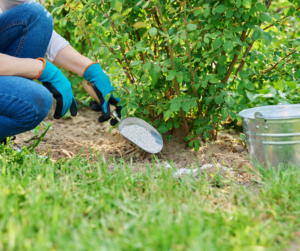Benefits of Diatomaceous Earth to Improve Plant Yields

Many growers wish there was a magical way to keep plants happy to increase yields. Fortunately, you don’t need to wait for a fairy godmother to appear to have your wishes come true! Diatomaceous earth could be your solution. It might not be fairy dust, but it’s the closest thing you’ll get to having magical growing powers because it improves soil conditions to optimize plants down to the cellular level. One of the many benefits of diatomaceous earth is that it decreases abiotic stressors such as drought and water logging, extreme temperatures, salinity, and mineral toxicity. Learn how you can use diatomaceous earth in the garden to decrease abiotic stressors and increase yields.
What Is Diatomaceous Earth?
Diatomaceous earth (also known as diatomite or DE) is the naturally occurring fossilized remains of single-celled aquatic algae called diatoms. They grow almost anywhere with water and sunlight, making them abundant around the entire world. These tiny, diatoms are incredibly important to the environment. Diatoms generate about 20 percent of the oxygen produced on earth each year—even more than the world’s rainforests!
Diatoms continue to improve the world when they die. The cell walls of diatoms are made of inorganic silica, ensuring they do not decompose when they die and become the fossils we know as diatomaceous earth. While there are many benefits of using diatomaceous earth in your garden, it’s this silica content that makes it stand out more than other substrates.
Silica and Abiotic Stressors
The key to reducing abiotic stressors is to make sure your plant has the nutrients required for resilience against abiotic stressors. You can do this by using plant-available silica (PAS) that is translocated to the plant’s cell wall through the roots of the plant. This silicon improves the structural integrity of the cells, allowing your plant to better defend against abiotic plant stressors like:
- Drought (water stress)
- Waterlogging
- Extreme temperatures
- Salinity
- Mineral toxicity
Sources of Silica
You’ll see many sources of silica (SiO2) on the market for gardening. But, there’s an important caveat: not all are created equal! You need to find a product that is soluble silicon, meaning the silica can be used by the plant. This is also known as Plant Available Silica. Diatomaceous earth is nearly 100% pure plant available silica so your plant can use the silica provided to improve the cellular structure, allowing it to better defend against stressors. This makes diatomaceous earth one of the most valuable substrates for your soil.
Standard soil is also a source of plant available silica, made of approximately 28% silicon. This silicon is bonded with oxygen and other elements in the crystalline fabric of mineral soil. Slag is another option. It is a by-product of the industrial processing of iron and other alloys. While it contains silicon, there can be other metals present, which can be toxic to your plants.
Beware of products that advertise silica content that isn’t plant available. Soil substrates like sand, pumice, and rockwool have SiO2, don’t provide plant available silica, so you won’t get the benefits provided by diatomaceous earth.
How Diatomaceous Earth Helps Increase Vegetable Yields
In addition to reducing abiotic stress through improved cellular structure, there are multiple ways your plants can benefit from the addition of diatomaceous earth.
- Moisture retention. Diatomaceous earth improves the retention of moisture in potting mix, soil, and sandy soil by holding a greater amount of fluid and drying at a slower rate.
- Drought resistance. The addition of diatomaceous earth to soil can increase drought resistance, which is particularly beneficial when added to the sand of golf putting greens.
- Add matrix to the soil. This helps prevent compaction, allowing proper oxygen to reach the root zone.
- Aids in reducing salinity. It promotes a neutral pH and improves soil conditions.
Harvest Hero Takes out the Guesswork of Using Diatomaceous Earth in Your Garden
Harvest Hero’s Perlite+ Silica! is a blend of perlite and diatomaceous earth to provide optimal growing conditions. Whether you’re growing cantaloupe, cucumbers, or cannabis, you’ll achieve optimal soil conditions for robust yields with this soilless blend.
- Natural soil substrate: an organic amendment that optimizes growth.
- Optimizes plant mass and plant growth by improving soil conditions.
- The silica fortifies the plant tissue to improve plant conditions in times of abiotic stress, like during temperature extremes, sunlight, and water extremes.
- Maintains high levels of oxygen in the soil.
- Increases availability of water and essential nutrients from the soil to your crops.
- The silica source provided by diatomaceous earth enhances resiliency towards abiotic environmental stress factors.
- Minimizes pH fluctuations by keeping oxygen levels consistent.



